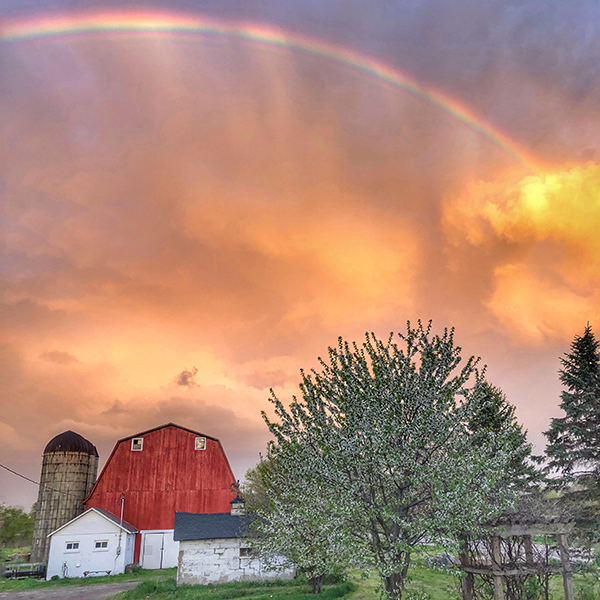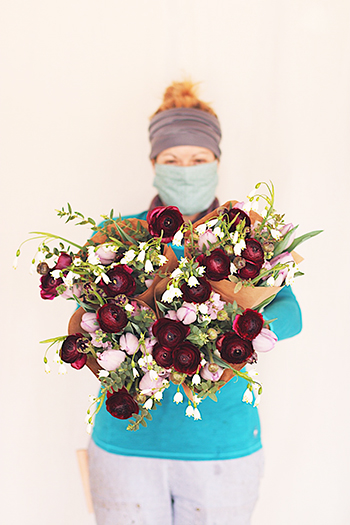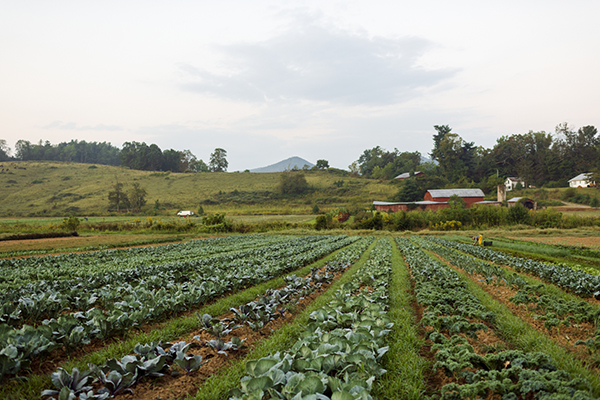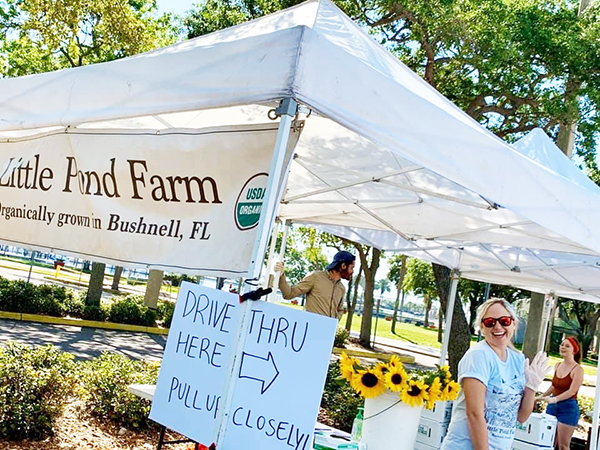By Kristen Muehlhauser
As human beings and as local food advocates, this is our time to step up as leaders and serve our communities. Every period of adversity in history gives us stories of people who saw urgent needs and rose up to meet them. The local, sustainable food movement has been building resilient systems for generations. Now is our time to shine!
Being a leader requires the ability to respond quickly. You have to survey the facts, take in the big picture, identify the critical needs that you have the power to meet, and create the solutions. As quickly as possible.
Local food has got this! We have an incredible opportunity to meet a felt, daily need of every person on this planet. We grow sustenance. We sustain human life. Adversity is the time for us to collectively reveal the strength of the local, small, place-based economies we have been working our whole lives to build.
Here is a breakdown of how we as farmers and producers can adapt and shine:
1. Survey the facts. If you have been swamped with the usual flood of spring farm work and you’ve been madly paddling to pivot your business model to adapt to closed markets, a review of the overarching story may be helpful. Many of us are too busy to follow the news, or don’t have the background in epidemiology that is necessary to forecast the big picture.
The urgent message I have for growers is that you need to assume the pandemic will affect your markets, mobility, labor force, and supply chain until at least mid-2021. Restrictions and reopening may come in waves. But the public health crisis will be with us until 1) a vaccine becomes widely available, 2) an effective treatment becomes widely available, or 3) the vast majority of the population is infected, recovered, and protected by immunity.
2. Take in the big picture. We are living through a crisis of public health and economic recession unlike any in the last 100 years, and we must adjust our business models ASAP. If your market has been temporarily closed, and you are waiting for it to reopen this spring, remember that if and when it does open, many of your customers will not be safe to shop in a crowded public space. People over 65 years and anyone with obesity, high blood pressure, diabetes, heart disease, or lung disease is at higher risk of severe illness and death. What percentage of your local community checks one of these boxes?
If you have not already created an online pre-order system or joined a collaborative online market, do that now if the retail market is an important part of your business. I never wanted to do custom packing of retail orders or delivery, but this is a special situation. Our at-risk community members need us. We don’t have to continue these models forever, but they will be important for the next two seasons.
3. Identify critical needs you have the power to meet. At this point, most of the US has been at least somewhat affected by disruption of the global food supply chain. People in your community are feeling this. When they order curbside from grocery stores or hire a personal shopper, they’re only receiving a fraction of what was on their shopping lists. Headlines about worker illness in food processing plants are scaring people. Many locations have quotas on meat and dairy.
All of us in small, sustainable agriculture know that we reach only a small percentage of our local communities with our food. Most people are still shopping at big grocery chains. But this year, you have what they need and want. If you have the capacity to increase production, do some thoughtful local marketing, and distribute safely, this could be the best year of your farming career. You can win over many new customers with the availability and taste of the most sustainable and tastiest ingredients. You just have to find way to offer pre-ordering with no-contact distribution or delivery.

Raindance Organic Farm in Whitmore Lake, Michigan. Photo courtesy of the author.
4. Create the safe solutions.
• To protect the health of the community, pre-ordering is essential. And pre-ordering is a win for your farm because you will only harvest and pack what is already sold! If you can sell your farm’s harvest before you plant it, then you will only sow and cultivate what has already been paid for. This is great news!
• Create a no-contact pickup. Your local farmer’s market may open. BUT, it is critical that we stand up as leaders in community health and lead by example in breaking the chain of transmission.
The basic principle is that the more people who share breathing air or contact surfaces, the more quickly the virus spreads. The public health interventions of staying home, wearing masks, cleaning and sanitizing surfaces are all meant to stop or curb the number of opportunities for the virus to pass from person to person through the air or through a person getting germs on their hands and putting those germs in their eyes, nose, or mouth. There are levels of risk mitigation here.
Examples
1. If I walk into a wash-pack with lettuce to wash and then an employee walks into a wash-pack two hours later with carrots, the virus can be passed because we have shared the same breathing space. The virus can hang in the air for three hours.
Safest intervention: If farm workers come from different households, wear a mask while working so the virus doesn’t spread from one household to another.
2. If I touch the trunk handle of my customer’s car to lift it to put in her box, and then she drives home and touches the handle to open the trunk, the virus can be passed because we have both touched that handle and the virus can live on metal and plastic up to three days.
Safest intervention: Wash hands before touching shared surfaces (trunk handle), so you don’t unknowingly put the virus on her handle. Wash your hands after touching her car, so you don’t pick up the virus and 1) put it in your airways by touching your face later or 2) put it on your pencil, phone, clipboard, cooler door handle, etc. and have another farm worker pick it up later.
3. If I stand at my socially-distanced market booth this May or June, and there is an active outbreak in my community with positive tests reported daily, the virus will be passed as customers breathe around my stand, browse for goods, stand in line, and exchange cash. The research being done in the last two months says that if all of the customers are wearing masks, it does reduce the total viral load being breathed into that shared air, but it does not eliminate it.
Safest intervention: Do not open a public shared space if there is an active outbreak (meaning new cases are being reported by your public health department) in your community. A farmer’s market is an event. Hundreds or thousands of people pass through shared breathing space in a short time period. If the virus is present, it will spread. It is true that people need food every day, and the virus is also being passed at grocery stores. That is why pre-order and no-contact pickup or delivery is the most safe setup.
This last example will be the most controversial. In communities without good access to fresh produce, farmers markets may actually provide the safest access to nutritious produce. As different regions experience peaks and lulls in infection rates throughout 2020, one community’s population will have already seen widespread infection and recovery, and the risk of passing the virus at that local market will be lower. In that same month, other regions will be seeing spikes in infection and risk of passing the virus at market will be very high. We will have to make choices every day on our farms and in our distribution based on local current conditions.
The problem with COVID-19 is that 25% of people who are actively infected are showing zero symptoms. They are walking around breathing in restaurant kitchens or market aisles, and they don’t know they are spreading the virus. The other huge problem is that science is still not certain about how long after infection a person is still contagious. Antibody testing will eventually tell us who among us has already had the virus, but we still does not know if antibodies in your blood 100% prevent you from getting sick again in the future. COVID-19 is only five months old, so we are still gathering data.
Think of the choices you make as a spectrum of intervention, and work to decrease risk while still providing essential, nutritious food to your community. Definitely wash hands. (Don’t just wear gloves because the virus will coat the outside of your unwashed gloves!) Definitely wear masks whenever people from different households are sharing breathing air. For the rest, follow your county health department on social media to stay up to date so you can make data informed decisions as the pandemic progresses.
Many of us farm because we want to do no harm with our work, and we want to serve others by increasing health, beauty, and community. The work of growing food is essential to human life and will continue through this crisis. But we have to understand the chain of virus transmission and how to break it if we want to be consistent and have integrity in our mission to increase health.
As a nurse and farmer, I am pleading with you to take the time to think through how the virus could be passed on your farm and in your distribution. Figure out a standard operating procedure that mitigates risk as much as possible. And then go crazy! Grow and sell like you have never done before! And if you have the means, be generous. Generosity in the face of adversity makes you feel good, and it will always be remembered by your community.
Kristen Muehlhauser founded Raindance Organic Farm in 2017 to serve her community in southeast Michigan by growing great organic food & flowers, and by connecting families with the beauty of nature and the gifts of wellness. She works off-farm part-time as an acute care nurse. You can follow her family’s story on social media
@RaindanceOrganicFarm.

 Practical advice on what’s working to replace lost business
Practical advice on what’s working to replace lost business
 It’s not too late for online/preorder seedling sales, farmers market custom bags, and We Give a Share
It’s not too late for online/preorder seedling sales, farmers market custom bags, and We Give a Share
 It became clear in March that the COVID-19 outbreak would disrupt almost every facet of life. So, we reached out to growers, asking for constructive ways they were keeping business going as safely as possible during the pandemic to share with you.
It became clear in March that the COVID-19 outbreak would disrupt almost every facet of life. So, we reached out to growers, asking for constructive ways they were keeping business going as safely as possible during the pandemic to share with you.